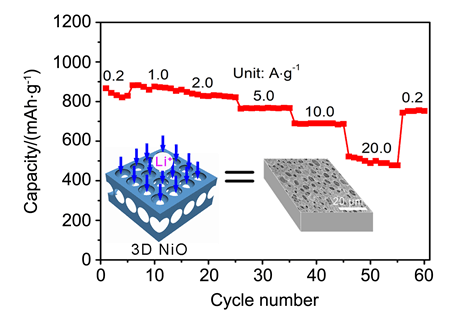| [1] Guo, Y.-G.; Hu, J.-S.; Wan, L.-J. Adv. Mater. 2008, 20, 2878.
[2] Xia, L.; Yu, L.-P.; Hu, D.; Chen, Z. Acta Chim. Sinica 2017, 75, 173. (夏兰, 余林颇, 胡笛, 陈政, 化学学报, 2017, 75, 173.)
[3] Liang, C.; Gao, M.-X; Pan, H.; Liu, Y.; Yan, M. J. Alloys Compd. 2013, 575, 246.
[4] Yu, P.; Liu, X.; Wang, L.; Tian, C.-G.; Yu, H.-T.; Fu, H. ACS Sustainable Chem. Eng. 2017, 5, 11238.
[5] Chang, S.-L.; Liang, F.; Yao, Y.-C.; Ma, W.-H.; Yang, B.; Dai, Y.-N. Acta Chim. Sinica 2018, 76, 515. (常世磊, 梁风, 姚耀春, 马文会, 杨斌, 戴永年, 化学学报, 2018, 76, 515.)
[6] Zhao, T. P.; Gao, D. S.; Lei, G. T.; Li, Z. H. Acta Chim. Sinica 2009, 67, 1957. (赵铁鹏, 高德淑, 雷钢铁, 李朝晖, 化学学报, 2009, 67, 1957.)
[7] Wang, X.; Qiao, L.; Sun, X.; Li, X.; Hu, D.; Zhang, Q.; He, D.-Y. J. Mater. Chem. A 2013, 1, 4173.
[8] Wen, W.; Wu, J.-M.; Cao, M.-H. Nano Energy 2013, 2, 1383.
[9] Wen, W.; Wu, J.-M.; Cao, M.-H. J. Mater. Chem. A 2013, 1, 3881.
[10] Kang, C.; Cha, E.; Lee, S. H.; Choi, W. RSC Adv. 2018, 8, 7414.
[11] Oh, S. H.; Park, J.-S.; Jo, M. S.; Kang, Y. C.; Cho, J. S. Chem. Eng. J. 2018, 347, 889.
[12] Zhang, Y.-H.; Wang, Z.-Y.; Shi, C.-S.; Liu, E.-Z.; He, C.-N.; Zhao, N.-J. Acta Phys.-Chim. Sin. 2015, 31, 268. (张远航, 王志远, 师春生, 刘恩佐, 何春年, 赵乃勤, 物理化学学报, 2015, 31, 268.)
[13] Sun, X.; Yan, C.-L; Chen, Y.; Si, W.; Deng, J.; Oswald, S.; Liu, L.; Schmidt, O. G. Adv. Eng. Mater. 2014, 4, 1300912.
[14] Lv, P.; Zhao, H.-L; Zeng, Z.; Gao, C.; Liu, X.; Zhang, T. Appl. Surf. Sci. 2015, 329, 301.
[15] Ma, J.; Yin, L.-W.; Ge, T. CrystEngComm 2015, 17, 9336.
[16] Yu, P.; Wang, L.; Sun, F.; Zhao, D.; Tian, C.; Zhao, L.; Liu, X.; Wang, J.-Q.; Fu, H.-G. Chem. Eur. J. 2015, 21, 3249.
[17] Vlad, A.; Antohe, V.-A.; Martinez-Huerta, J. M.; Ferain, E.; Gohy, J.-F.; Piraux, L. J. Mater. Chem A 2016, 4, 1603.
[18] Park, G.-D.; Hong, J.-H.; Park, S. K.; Kang, Y. C. Appl. Surf. Sci. 2019, 464, 597.
[19] Fan, Z.; Liang, J.; Yu, W.; Ding, S.-J.; Cheng, S.; Yang, G.; Wang, Y.; Xi, Y.; Xi, K.; Kumar, R. V. Nano Energy 2015, 16, 152.
[20] Liang, J.; Hu, H.; Park, H.; Xiao, C.; Ding, S.-J.; Paik, U.; Lou, X. W. Eng. Environ. Sci. 2015, 8, 1707.
[21] Park, S. K.; Choi, J. H.; Kang, Y. C. Chem. Eng. J. 2018, 354, 327.
[22] Zou, F.; Chen, Y. M.; Liu, K.; Yu, Z.; Liang, W.; Bhaway, S. M.; Gao, M.; Zhu, Y. ACS Nano 2016, 10, 377.
[23] Hien, V.-X.; Vuong, D. D.; Chien, N. D.; Heo, Y.-W. Mater. Chem. Phys. 2018, 217, 74.
[24] Jiang, J.; Ma, C.; Yang, Y.; Ding, J.; Ji, H.; Shi, S.; Yang, G. Appl. Surf. Sci. 2018, 441, 232.
[25] Long, H.; Shi, T.; Hu, H.; Jiang, S.; Xi, S.; Tang, Z.-R. Sci. Rep. 2014, 4, 7413.
[26] Meng, X.; Deng, D. Chem. Eng. Sci. 2019, 194, 134.
[27] Xia, Y.; Sun, B.; Zhu, S.; Mao, S.; Li, X.; Guo, B.; Zeng, Y.; Wang, H.; Zhao, Y. J. Solid State Chem. 2019, 269, 132.
[28] Hu, N.; Tang, Z.; Shen, P. K. RSC. Adv. 2018, 8, 26589.
[29] Fan, X.-Y.; Han, J.-X; Jiang, Y.; Ni, J.; Gou, L.; Li, D.-L.; Li, L. ACS Appl. Energy Mater. 2018, 1, 3598.
[30] Fan, X.-Y; Shi, Y.; Gou, L.; Li, D. Electrochim. Acta 2014, 142, 268.
[31] Sun, C.; Yang, J.; Rui, X.; Zhang, W.; Yan, Q.; Chen, P.; Huo, F.; Huang, W.; Dong, X. C. J. Mater. Chem. A 2015, 3, 8483.
[32] Feng, Y.; Zhang, H.; Li, W.; Fang, L.; Wang, Y. J. Power Sources 2016, 301, 78.
[33] Yang, W.; Cheng, G.; Dong, C.; Bai, Q.; Chen, X.; Peng, Z.; Zhang, Z.-H. J. Mater. Chem. A 2014, 2, 20022.
[34] Ni, S.; Lv, X.; Ma, J.; Yang, X.-L.; Zhang, L. J. Power Sources 2014, 270, 564.
[35] Hu, Y.; Wei, J.; Liang, Y.; Zhang, H.; Zhang, X.; Shen, W.; Wang, H.-T. Angew. Chem. Int. Ed. 2016, 55, 2048.
[36] Wu, J.; Yin, W. J.; Liu, W.-W.; Guo, P.; Liu, G.; Liu, X.; Geng, D.; Lau, W.-M.; Liu, H.; Liu, L. M. J. Mater. Chem. A 2016, 4, 10940.
[37] Kvasha, A.; Azaceta, E.; Leonet, O.; Bengoechea, M.; Boyano, I.; Tena-Zaera, R.; Meatza, I. d.; Miguel, O.; Grande, H.-J.; Blazquez, J. A. Electrochim. Acta 2015, 180, 16.
[38] Yan, X.-Y.; Tong, X.; Wang, J.; Gong, C.; Zhang, M.; Liang, L. J. Alloys Compd. 2013, 556, 561.
[39] Fan, X.-Y.; Zhuang, Q.-C.; Wei, G.-Z.; Ke, F.-S.; Huang, L.; Dong, Q.-F.; Sun, S.-G. Acta Chim. Sinica 2009, 67, 1547. (樊小勇, 庄全超, 魏国祯, 柯福生, 黄令, 董全峰, 孙世刚, 化学学报, 2009, 67, 1547.)
[40] Fan, X.-Y.; Shi, Y.-X.; Cui, Y.; Li, D.-L.; Gou, L. Ionics 2015, 21, 1909. |
